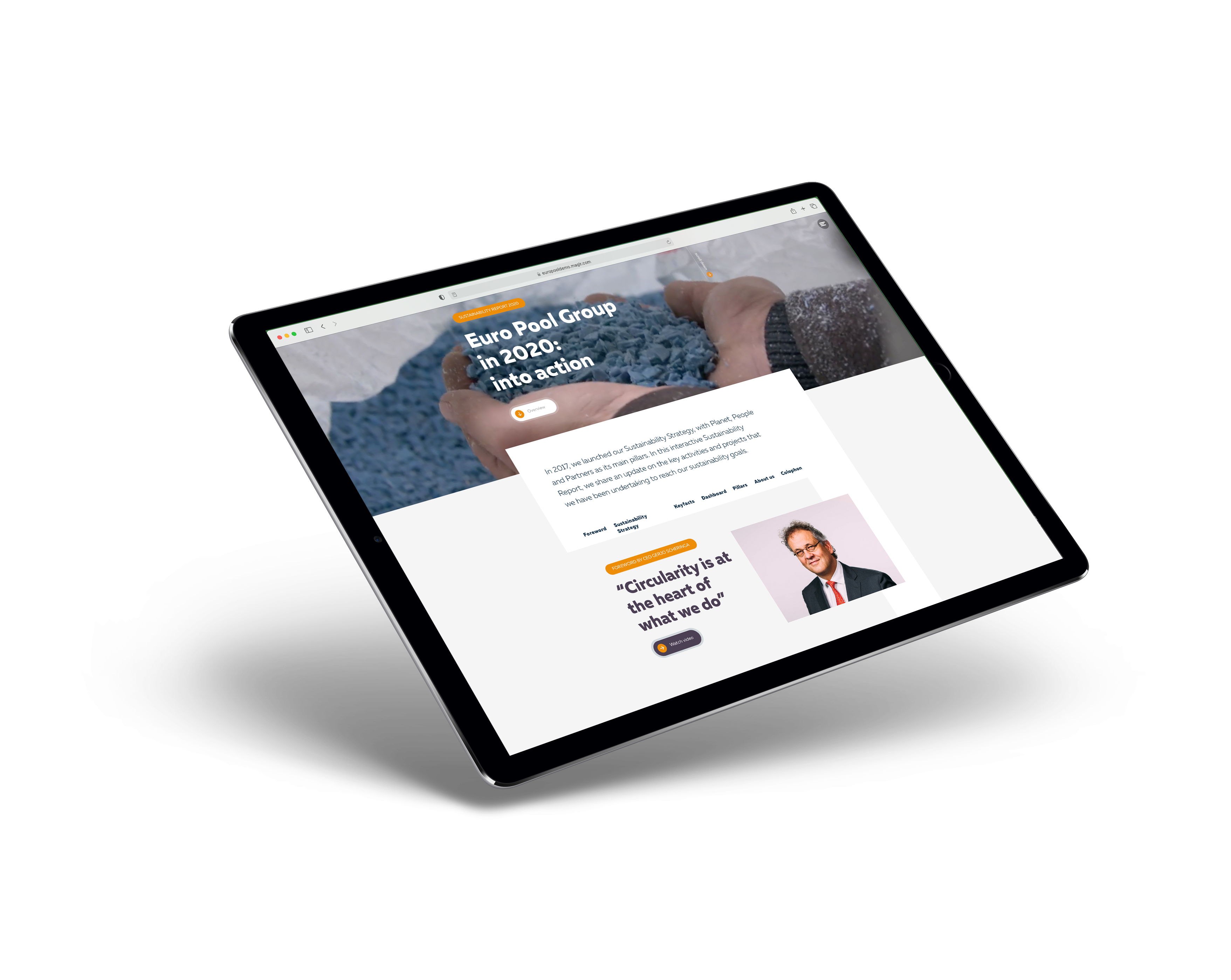In the years to come, businesses around the world will find themselves under ever-increasing pressure to play their part in the fight against climate change. This will push them to find new, more responsible modes of production and consumption.
The supply chain is not immune from these pressures, in fact, quite the opposite.
Whilst there are already some solutions available, many companies continue to ignore the climate emergency in favour of profitability.
One such solution is to ensure that your supply chain is ready to become part of the circular economy, resulting in a more sustainable, and just as profitable, system!
Quick Navigation:
1 - Why include your supply chain in the circular economy?
1.1. Definition of circular economy
1.2. The 7 pillars of the circular economy
1.3. Reasons to include your supply chain in the circular economy
2 - Existing solutions to make your supply chain more sustainable
2.1. Pallet pooling for a more circular supply chain
2.3. Optimise your logistics flows
2.5. Promote renewable energies for your supply chain
1. Why include your supply chain in the circular economy?
1.1. Definition of circular economy
In the UK, the term circular economy was first used in 1988 with the publication of the book “The Economics of Natural Resources” by Allen V .Kneese.
At LPR - La Palette Rouge, our pallet pooling activity has been circular since our creation in 1992.
However, the European Union only introduced its vision of the circular economy in 2014, which gave birth to a “New action plan for the circular economy” in 2020. Its objective? To show the way to a competitive and sustainable economy.
But, what is the circular economy?
The circular economy is a sustainable, economic model based on the reuse of resources (unlike conventional economic models which are based on the destruction of resources to produce wealth).
The circular economy makes it possible to move from a linear supply chain, where disposability is the norm, to a supply chain that upgrades and repairs what it produces thanks to a circular system.
Let’s explore the seven fundamental pillars on which the circular economy is based.
1.2. The 7 pillars of the circular economy
a) Sustainable sourcing
Sustainable sourcing is the first pillar of a circular economy supply chain. The concept is simple: reduce the quantity of raw materials by favouring more efficient, more ethical and more sustainable methods of extraction and supply.
At LPR, 83% of the wood used in the production and repair of our pallets comes from PEFC certified forests.
PEFC-certified forests are controlled by the Forest Certification Recognition Programme. These are sustainably managed forests in more than 55 countries around the world. This programme aims to ensure the sustainable use of forests, taking into account environmental, social and economic issues.
b) Ecodesign
The principle of eco-design considers the environmental angle from the very start of designing a new product or service. Examples include reducing packaging, sourcing raw materials more locally, or by manufacturing products with a longer life expectancy, or that are easier to repair or reuse.
At LPR - La Palette Rouge, eco-design is part of our DNA. Since our inception in 1992, we have provided pallet rental services that prioritise resource reuse over repurchase. Our customers benefit from robust, repairable and reusable pallets.
c) Industrial and territorial ecology
Industrial and territorial ecology is a key concept for integrating your supply chain into the circular economy. It allows companies in the same territory to pool their resources to optimise their use.
This concept can be translated into various actions at a local level:
-
The pooling of waste management and the sharing of materials: for example, all green waste from an industrial zone can be used to produce methane, in exchange the methaniser can heat the provider’s company warehouses at a lower cost.
-
The sharing of equipment (such as a heating network) to limit consumption and CO2 emissions.
-
Inter-company agreements to obtain local supplies and reduce transport costs
d) The functional economy
The functional economy promotes reuse rather than additional purchase. It encourages the rental of equipment, as opposed to purchase, when the need arises.
Leasing allows companies to be flexible in the face of demand, by adapting their supply according to need, reducing the production and use of additional resource.
At LPR - La Palette Rouge, pallet pooling works on a rental basis. Companies can be flexible in their demand for pallets, depending on their needs – ordering only those necessary. Companies reduce their costs and no longer need to store unused pallets.
It couldn’t be simpler:
-
Customer sends their order forecasts;
-
Customer orders pallets on the MyLPR portal;
-
LPR delivers the ordered pallets;
-
The customer uses our pallets to fulfil their obligations;
-
The customer informs us where the pallets have been delivered to;
-
We recover the empty pallets;
-
We then sort and repair them, before puting them back into circulation.
e) Responsible consumption
For a supply chain that is better anchored in the circular economy, it is necessary to encourage all of its members to commit to a more environmentally friendly supply chain. This is made possible by encouraging them to:
-
Extend the duration of use;
-
Choose suppliers that are more respectful of the environment;
-
Reduce their consumption of non-renewable energies;
-
Reduce their CO2 emissions;
-
Prefer repair to purchase and reuse of resources.
f) Recycling
Recycling is essential if you want to make your supply chain part of the circular economy. By promoting the manufacture of products that are easy to reuse, you are taking concrete action for the environment. When recycled, this waste can then be transformed into new resources that can be resold and used by other parties.
LPR - La Palette Rouge pallets are repaired until they can no longer be repaired, when they are recycled into wood pellets for heating, meaning there is no waste.
1.3. Why should you make your supply chain part of the circular economy?
a) Because ecology concerns us all
Supply chains are responsible for a large percentage of global CO2 emissions.
In 2015, the McKinsey company produced a report showing that consumer goods (FMCG) production companies are responsible for the emission of approximately 33 gigatonnes of CO2 (1 gigatonne = 1 billion tonnes) annually.
To meet global climate goals, these emissions will need to be almost halved by 2050, to 15 gigatonnes annually.
b) Because the circular economy is good for your business
In addition to the environmental aspect, the benefits of a supply chain anchored in the circular economy include:
-
Reduce expenses, thanks to pooling.
-
Anticipate and meet the requirements of legislation which is expected to intensify in the years to come in the face of the climate emergency.
-
To set up a sustainable and responsible dynamic that translates into values that unite your employees (by putting them at the heart of a project that makes sense and meets their environmental concerns)
c) Because the circular economy creates jobs
The International Labour Organisation (ILO) estimates that increased recycling activities would largely offset the job losses associated with reduced resource extraction.
The organisation estimates that a more circular model would increase the number of jobs worldwide by 0.1% by 2030. It also estimates that the waste management sector and the service sector could alone create between 50 and 45 million jobs respectively.
More information can be found by reading their report. Page 6 of the report includes a table of the sectors most impacted by a transition to the circular economy.
d) Because the circular economy is good for your company’s image
Being a company focussed on sustainability can provide a positive benefit to your company’s image.
According to Eco Friendly Habits, 48% of US consumers say they are ready to change their consumption habits in favour of a greener model. These same consumers spent $128.5 billion on more sustainable FMCG products in 2018, and this trend is accelerating.
In addition, investing in the circular economy also means investing in your employer brand. According to a recent report by Unily, 83% of employees believe that their employer does not do enough to benefit the environment. 65% of them admitted to preferring to work for a company with a strong environmental commitment. This phenomenon is explained by employees desire to give more meaning to their job, and to work for an employer who will take good care of them, and their future.
Today, more and more private or public “green” investment funds are investing their money in ecological transition projects, or into companies that have a beneficial impact on the environment. This trend is a strong signal for companies in all sectors and should encourage them to invest significantly in their ecological transition.
As a business it is difficult to ignore the need for a more environmentally friendly approach.

2. Existing solutions to make your supply chain more sustainable
2.1. Pallet pooling for a more circular supply chain
Pallet pooling is a 100% outsourced pallet rental/management system. As it is a rental system, it means less capital expenditure for your business. The ordered pallets are delivered, and collected once used. They are then repaired and put back into circulation within the pallet pool.
This solution has several advantages:
-
You have flexibility to meet your changing needs. For example, a brewer, does not need the same number of pallets in December as in August. Pallet pooling provides flexibility to meet demand.
-
There are no storage, repair, logistics management and pallet renewal costs.
-
Reduced administrative management related to your stock of pallets.
-
You make a significant step towards a more sustainable supply chain. By using pallet pooling, you become part of the circular economy.
By choosing pallet rental (rather than purchase), you are choosing a model that optimises your entire supply chain. You pay to use, not to own, so you only consume what you need.
2.2. Use recyclable packaging
Choosing recyclable packaging means choosing to reduce the environmental impact of your supply chain.
This is the Euro Pool System’s primary aim. Thanks to their system of green foldable and stackable trays, the company has established itself as one of the leaders for the circular economy in Europe.
The concept? Provide food manufacturers with recyclable and reusable trays to reduce the use of non-recyclable plastic packaging and the use of single-use cardboard packaging, while providing better protection for the goods transported.
Once used, washed and repaired, these trays can be folded and stacked to allow for larger transport volumes, thereby significantly reducing CO2 emissions.
2.3. Optimise your logistics flows
Using transport flow optimisation can be used to help you to reach your sustainable supply chain objectives. You can:
1. Minimise empty miles, optimise customer loops, set up on-site depots.
2. Choose hauliers whose fleets are greener and who have a concrete commitment to the environment. For example, youshould check that they are accredited with:
-
The FTA charter (UK)
-
The ISO14000 standard (Europe)
-
or participate in the Lean & Green programme
Multimodal transport can be used for a more ecological approach. Multimodal transport favours cleaner transport options, e.g. rail.
Finally, you could use a business which specialising in transport traceability, such as Shippeo. These businesses optimise routes, track them and select the most responsible transport methods.
2.4. Waste recycling
All companies that produce consumer goods also produce waste. One of the main challenges of the circular economy is to reduce CO2 emissions linked to waste management. Several solutions exist:
-
Consolidation of waste collections bythose working in the supply chain, to reduce empty miles, and therefore CO2 emissions.
-
The transformation of your waste into a new resource (for example, the transformation of green waste into compost).
-
Use compactors to reduce the space taken up by waste and reduce your transport needs.
2.5. Promote renewable energies for your supply chain
To go even further in the circular economy, it is possible to make your supply chain greener, thanks to some very simple steps:
The use of solar panels on your buildings can help you meet your business’s electricity needs. In addition to producing greener and renewable energy, any additional electricity may be resold.
You could also install a green roof, which will provide a green space for your employees, and allow you to better insulate your buildings in winter and summer. This solution can reduce your heating or air conditioning bills, and the plants will also absorb CO2.
Install rainwater harvesting solutions. Euro Pool System uses this solution to wash its reusable trays. This system can also offer significant water savings for your wallet!
Even the smallest of gestures can lead to major energy savings. By taking care to turn off your lights at night or by changing your traditional bulbs for low-energy bulbs, you are doing good for the planet.
Whilst the climate and environmental issues are a real challenge for businesses around the world, there is still a lot of progress to be made.
Fortunately, solutions already exist to help businesses operate more circular supply chains, and move towards a supply chain that is efficient, economical and responsible.
If you would like to discuss your logistics issues with our business experts, you can contact them here. You can also access our other blog articles to learn more about supply chain and pallet pooling.


